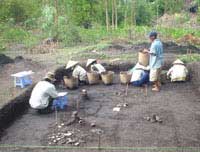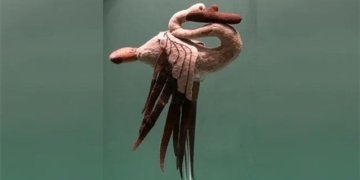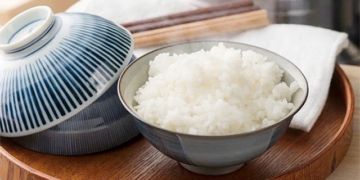 |
Excavation scene at the Lò Gạch site |
Initial excavation results at the ancient village known as Lò Gạch have demonstrated that humans were present here quite early. Moreover, they contributed to the creation of the famous Óc Eo culture in the Mekong Delta.
The excavation of the ancient village Lò Gạch in Vĩnh Trị commune, Vĩnh Hưng district, Long An province began in late November 2005.
Associate Professor Trịnh Sinh from the Vietnam Archaeology Institute stated that researchers have collected a substantial number of artifacts reflecting the entire life of an ancient population in the Đồng Tháp Mười region. This includes pottery, fragments of containers, and cooking utensils, densely packed within a cultural layer over 1 meter thick. Additionally, many deer bones, fish bones, pointed tools made from bone and animal horn, and fragments of bronze axe molds were also discovered.
The excavation revealed a landscape resembling that of today, heavily influenced by the river systems of the Mekong Delta. Adapting to the environment, ancient people chose elevated mounds for habitation – what we would today refer to as “living with floods.” The flooding season has been the harvest time for local residents for thousands of years, continuing to this day.
The quantity of artifacts unearthed indicates that ancient people primarily relied on fishing. However, they also had a long-term settled lifestyle, evidenced by pottery-making skills, with high-fired ceramics and large ceramic production tools such as pounding tables.
The ancient people also crafted stone rings for adornment and were skilled in hunting large animals such as deer in the surrounding forests. After consuming the meat, they retained the antlers to saw, polish, and create exquisite jewelry or to make pointed tools.
Analyzing the shapes and patterns of the pottery, scientists have preliminarily noted that the ceramics from the Lò Gạch site are quite similar to those from An Sơn, Gò Ô Chùa, Rạch Nổi, and other sites in the region. These cultural markers indicate that this is one of the sources contributing to the renowned Óc Eo culture.
Nearly a century ago, when excavating the famous Óc Eo archaeological site in the Mekong Delta, dated a few hundred years post-Christ with a high level of civilization, featuring beautiful glass and gold jewelry, as well as ancient coins evidencing exchanges with many ancient countries in the region and the Western world, French scholar Luis Malleret did not understand where this civilization originated.
“Thanks to recent archaeological discoveries in the Mekong Delta, with sites like Lò Gạch, we now see that this famous culture has roots in indigenous cultures that date back a few hundred years earlier,” Mr. Sinh remarked.
This excavation also indicates a broader cultural exchange – between the Southwestern region of our country and the riverside areas of the Mekong in Thailand and the upper reaches of Yunnan, China, around two thousand years ago.




















































